Temperature issues.
For an index of all my Mac Pro articles, click here.
Long time readers will recall that what drove me to using a Hackintosh five years ago was that I managed to fry the GPUs in three iBooks and two iMacs in quick succession. The last two were just out of warranty, naturally, and my efforts to better ventilate the nVidia 7300 GPUs and then to replace the 7300 in one with a 7600 all failed. Further, Apple denied any cooling issue existed even though their own discussion boards were replete with complaints. This led me to put out the iMac in disgust to a location better suited to its abilities:
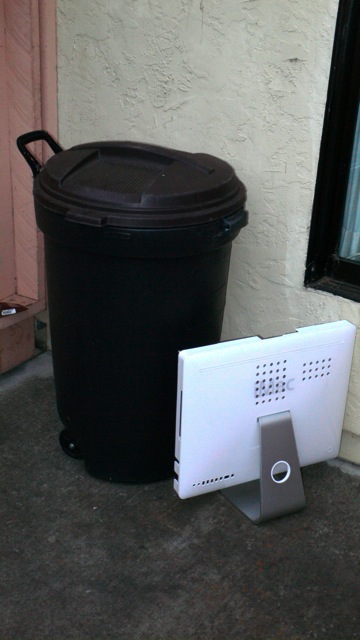
The garbage awaiting collection
Thus it comes as no surprise that I have kept a watchful eye on operating temperatures ever since and even though the Mac Pro comes with state-of-the-art cooling, it’s a hard habit to shake.
The purpose of this piece is to address Mac Pro temperatures and suggest one minor enhancement.
The Mac Pro is exceptionally well cooled, with six fans in the 8-core model. (The 4-core has five, as it has one processor, not two). One pair of fans cools the processor cage in a push-pull configuration, each massive processor heat sink contains a fan, the PCIe fan cools the space occupied by the PCIe cards and disk drives and the large 980 watt power supply has its own fan.
The other day I ripped a movie then compressed it using Handbrake. That’s a stressful process which exercises all 8-cores in the two Intel Xeon CPUs used in the 8-core Mac Pro. It was an exceptionally warm day and the Ambient (case vicinity) temperature reported by iStat was 90F. All the operating temperatures of the various monitored components were fine, running in the 120F range, but with one exception. The Northbridge chip was reporting 165F. The fans did not spool up and the job ran fine, a full length uncompressed movie being reduced to a compressed iPad M4V version in 25 minutes. Nice.
Well, I did some reading of chat boards and they were – how to put this politely? – innumerate.
Thus, I went to the source, the excellent Intel web site, to check on the Northridge thermal specifications. Northridge is the chip which controls communications between the CPU and RAM, and Wikipedia has a fine piece on it here. Note that the increasing drive to integration saw the Northbridge chip move within the CPU case by the time Intel produced the later Sandy Bridge CPUs, which is what my Hackintosh used.
Intel’s thermal specs provide the definitive answer in their Northbridge Thermal Guide. Here’s the key extract:
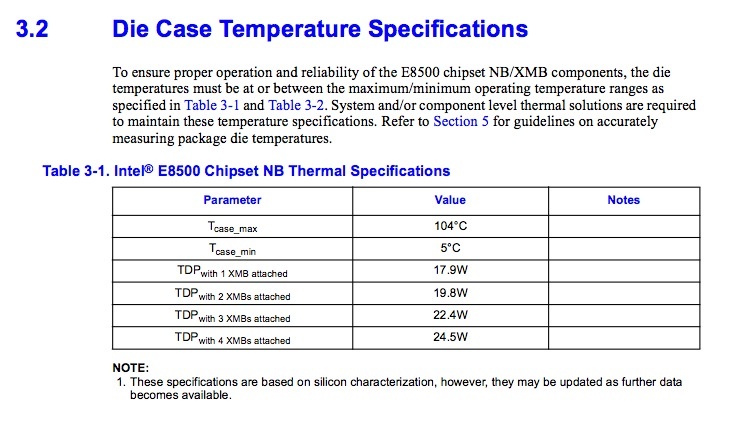
Northbridge temperature limits.
I’m strictly a Farenheit guy and water boils at 212F at sea level in my world, so Intel’s 104C converts to 219F as the case temperature limit for the Northbridge chip. One commentator on a chat board stated he removed the chip and refreshed the thermal paste, but the loss was only 4F, which hardly seems worth the effort.
Nonetheless, as I never like to see high temperatures, I did some measurement. Here’s my iStat reading with the Mac Pro just doing some modest surfing:
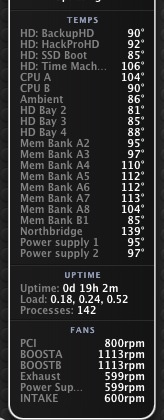
Stock, static temperatures.
I then fired up SMCFanControl, which you can download free – click the link, and increased the fans speeds of the processor cage Intake and Exhaust fans from 800rpm to 1050rpm, thus:
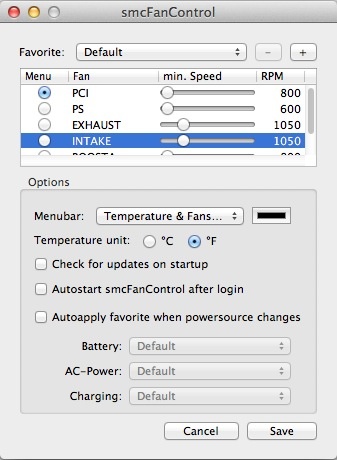
Intake and exhaust fan speeds.
The processor assembly is the part-withdrawn assembly in the picture below (4-core above, 8-core below), holding the two CPUs, RAM and, yes, that hot Northbridge chip. There are two CPU fans within the heat sinks on an 8-core machine, named BOOSTA and BOOSTB, the first barely distinguishable in the image above:
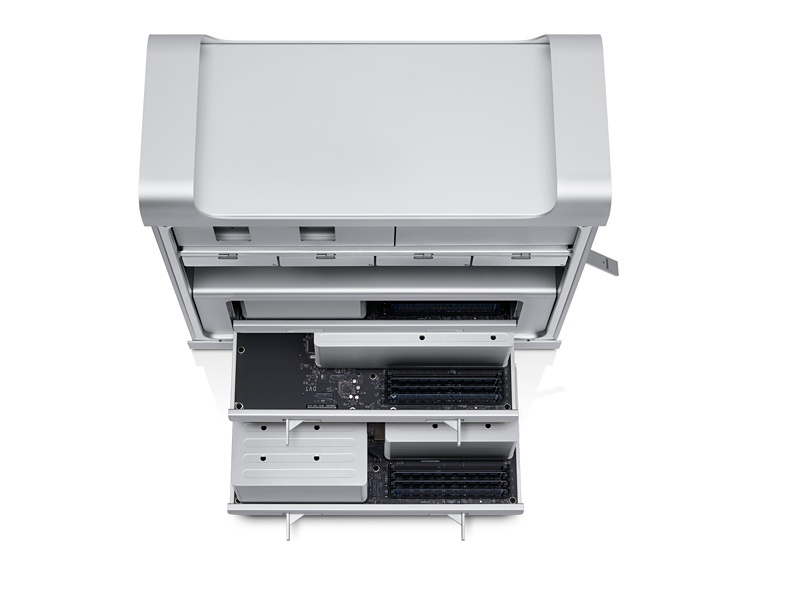
Processor assembly partly withdrawn.
This assembly nests within the processor cage which I earlier removed to install an Airport card on the backplane board:
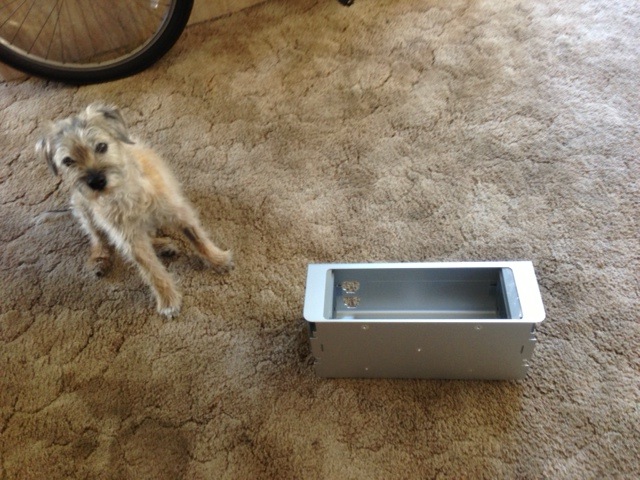
The ever diligent hound guards the processor cage.
Note how the fans have been moved in 1/2″ toward the center of the cage.
Those fans, which work in a push-pull configuration, are the ones we want to speed up if more air flow is to be directed over the Northbridge chip.
The modest speed increase for the minimum fan speeds from 800rpm to 1050rpm resulted in a 1-2dB noise increase at my working location, in practice barely detectable. But the benefit in terms of Northbridge temperature drop was excellent:
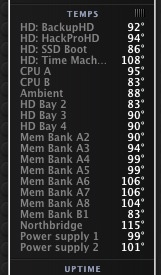
Northbridge temperature
drops 24F after modest fan
speed increase.
That’s a good noise:efficiency trade-off in my book and I’m leaving those two fans at that speed.
To satisfy curiosity, I cranked those two fans up to 3600+rpm, resulting in an unnacceptable noise level of 60dB. Not for daily use, but handy if you need quick cooling on a stressful task in excess of that offered by the automatic variable speed fan controllers in the Mac Pro. The Northbridge now dropped from 139F stock to 101F:
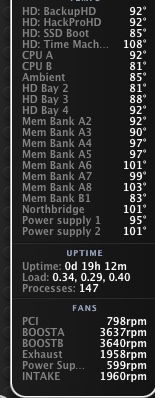
The fans cranked up.
Bottom line? For the temperature-obsessed, like me, a slight increase in fan speed to 1050rpm from the stock 800rpm for the intake and exhaust fans on the processor cage provides peace of mind.
It’s hot and I want to leave the cover off:
That is a bad idea. The Mac Pro’s massive alloy side cover plate is part and parcel of the thermal design. Look hard at the inside and you will see insulating rubber gaskets which seal the enclosure when the cover is in place.
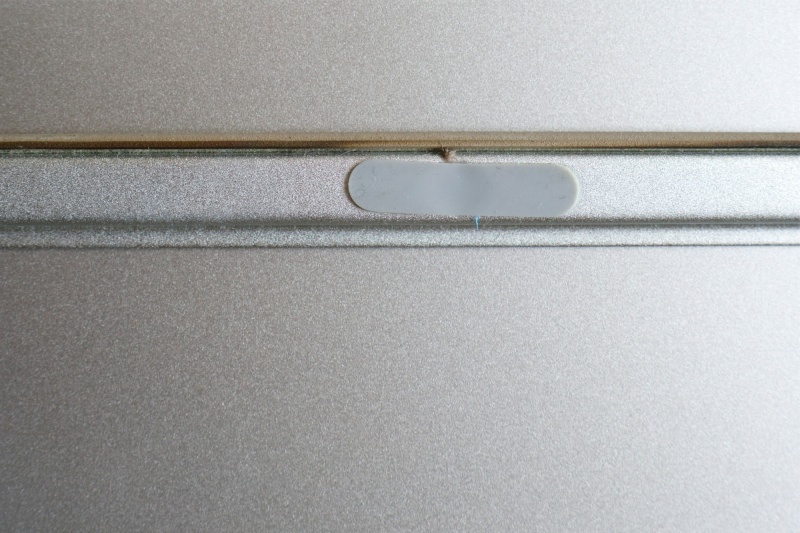
The rubber seal inside the Mac Pro’s side cover.
With the cover in place the tunnels formed by the cover are completed, presenting a side-sealed conduit for the push-pull processor cage fans, resulting in optimal cooling. Leaving the cover off actually compromises cooling performance. Do not do it.
Hey, what’s your favorite beverage? I might drive 2 hours up and drop off a 12-pack for you. I’m waiting for my ebay Mac Pro to arrive, and while I’m waiting…this series on the Mac Pro has been awesome! I stayed up past my bedtime reading the first 9, and Part X was even better! I like your use of measurement and empiricism…like you, I have an obsession about heat issues (although I never had your problems–I avoided the iMac like the plague) and the temp reduction using smcFanControl will save me some time and effort (although I’m geeky enough to take my own measurements).